Bengali Heritage Trail
The Bengali Heritage Trail around Tower Hamlets will unlock the history of Britain’s first Bengali settlers, seamen known as Lascars, and will connect key landmarks such as the docks and buildings associated with the seamen who served on British naval and merchant ships from the 17th century onwards. The trail will be described in a booklet made available and online and at a special exhibition and seminar.
The research project will explore the history of the Lascars who were recruited in India to work for the East India Company. The trail will take in the sites of East India House and Calcutta House, East India Dock in Blackwall, and Seaman’s Lodgings. It will also include buildings resulting from the settlement of the Bengali Community, including the Brick Lane Mosque and the Kobi Nazrul Centre; and memorials such as the Altab Ali Arch and the Shahid Minar monument.
The project will offer unique opportunity for young people to research, document and celebrate Bengali history and heritage by producing the heritage trail. The young people involved with this project will learn about their community’s heritage, acquire skills in research, photography, uploading website, publication and furthermore will pass on this knowledge to other young people.
The project will work in consultation with Tower Hamlets Local History Library, London Metropolitan University and the Bishopsgate Institute.
The project started in November 2008 and will be completed in August 2010.

Sponsored by

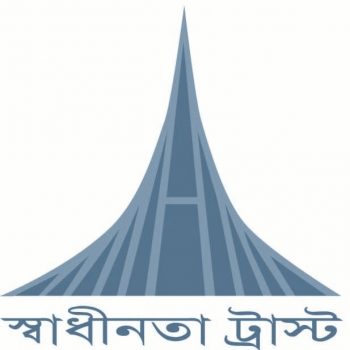

Volunteers training provided by


Tower Hamlets Bengali Heritage Photo Gallery
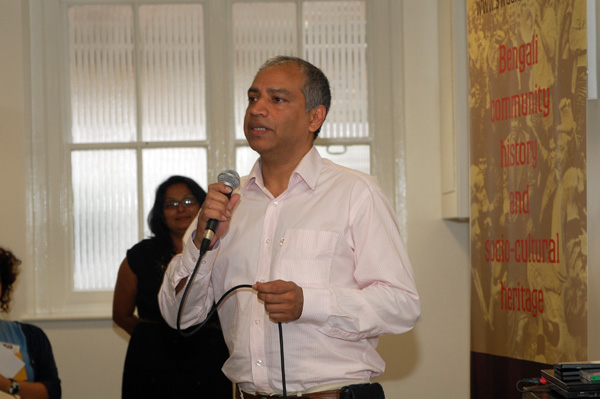

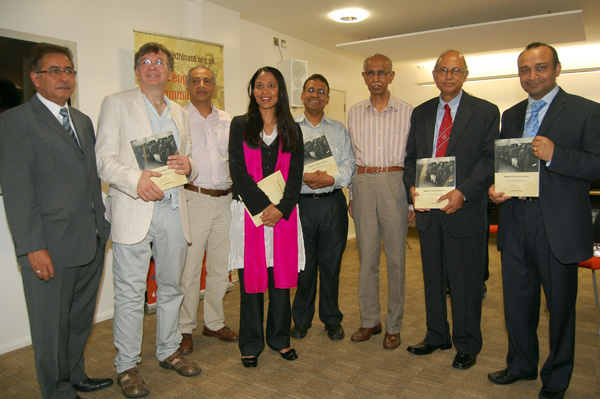
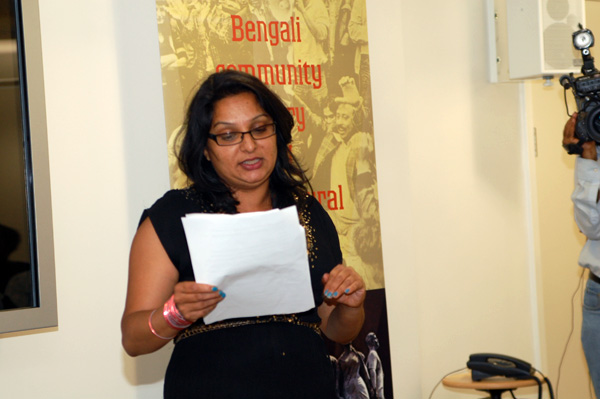
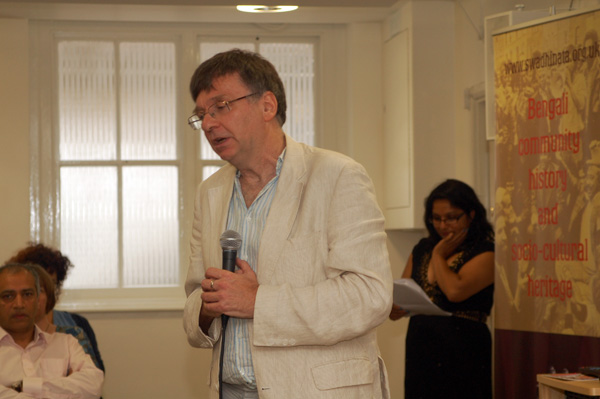
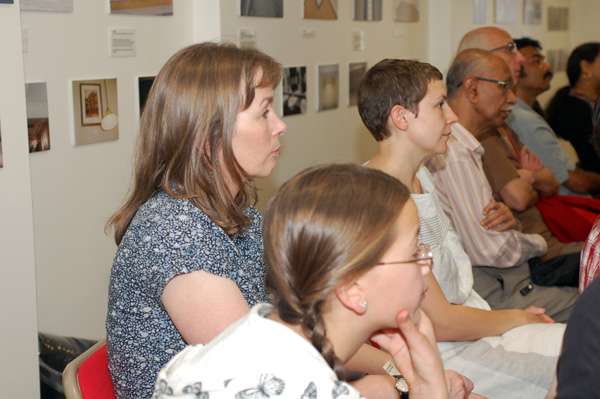
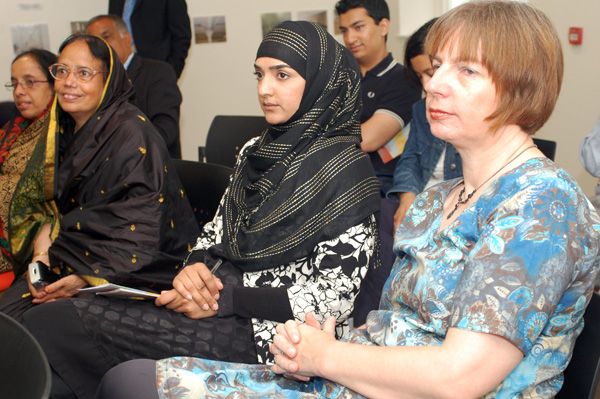

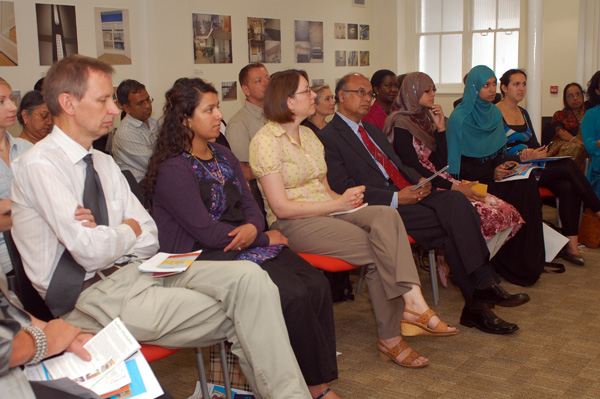
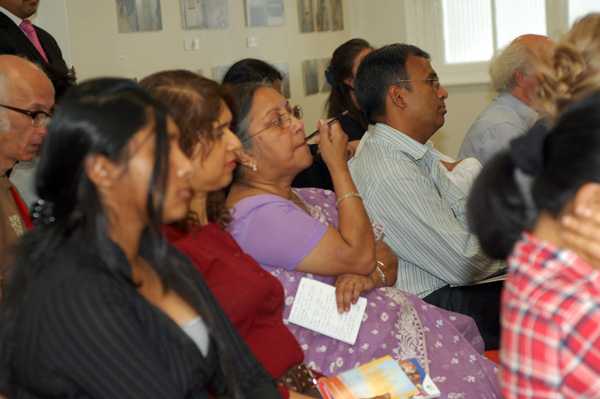
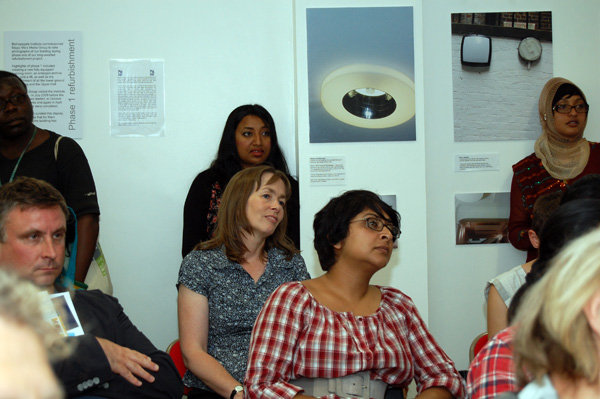
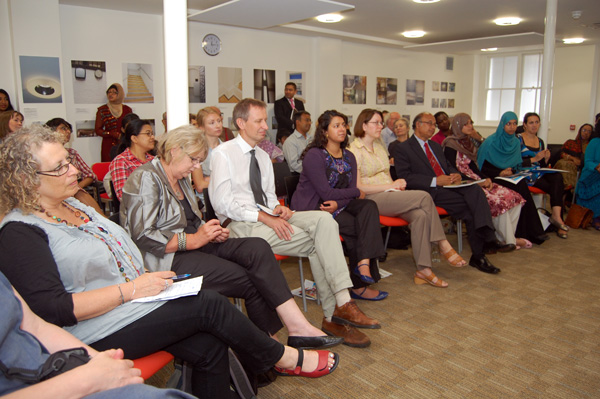
Bengalis in London’s East End
The exhibition ‘Bengalis in London’s East End
The Bengali Heritage Trail around Tower Hamlets unlocks the history of Britain’s first Bengali settlers, seamen known as Lascars, and connects key landmarks such as the docks and buildings associated with the seamen who served on British naval and merchant ships from the 17th century onwards. The exhibition is linked to a book titled ‘Bengalis in London’s East End’.
‘The Lascars were recruited in India to work for the East India Company. The trail covers the sites of East India House, Calcutta House, East India Dock in Blackwall, and the Seaman’s Lodgings. It also includes buildings resulting from the settlement of the Bengali Community, including the Brick Lane Mosque and the Kobi Nazrul Centre; and memorials such as the Altab Ali Arch and the Shahid Minar monument.
Exhibition Panel (PDF)
Beginnings
It is commonly believed that the Bengali presence in the UK is something relatively new, at its earliest, from the years following the Second World War.
In fact, this is very far from the case. The connection goes back over 400 years, right to the beginnings of British involvement in India. Much of what we know of this history comes from the India Office Records.
Books, periodicals and photographic collections add to this wealth of information, as do the personal papers of both British officials and Indian personalities of the time.
Exhibition Panel (PDF)
Settlements of sailors
Although some early Bengali migrants to Britain were servants, most were sailors recruited in India to work on merchant ships. The majority of Bengali seamen came from Sylhet, but others came from Chittagong and Noakhali. Their presence was noticed as early as 1765, when an Indian visitor to Britain wrote, ‘The English were not unacquainted with [men from] Chatgaon (present day Chittagong) and Juhangeernuggur (Jahangir Nagar present-day Dhaka).
Over the years, the community grew slowly, and by the beginning of the 20th century, groups of seamen and ex-soldiers, including a number of Bengalis, had settled near the docks of East End of London, Cable St and the Shadwell area. They joined the small number of Asian professionals mainly doctors, businessmen and lawyers who had established themselves in Britain from the middle of the 19th century.
Exhibition Panel (PDF)
Settlements in the 1950s
Among the settlers who arrived in the East End in the 1950s was Syed Abdul Kadir, who now lives in Poplar. He served in the Pakistan Navy from 1950 for twenty two years before retiring as a marine engineer in 1972. He came to the UK in 1953 to attend the Queen’s coronation at Westminster Abbey as guard of honour of the Pakistan Naval ship, PNS Zulfiquar. During Pakistan’s war with India in 1965 he was in active service. During Bangladesh’s Liberation War in 1971 he escaped West Pakistan to fight with Bengali freedom fighters.
Sea Captain Shiv Banerjee came to the UK in 1967, arriving at Tilbury Docks, as a cadet with the India Steamship Company. He then sailed around different parts of the world as an Officer in the Merchant Navy. In 1975 he studied at the School of Navigation which is now the London Metropolitan University site at Tower Gateway. The pictures also show his Master’s Certificate and Seaman’s Identity Card part of which is in Bengali. In the early days he lived at Beacon House, Dock Street – then, a seaman’s hostel.
Exhibition Panel (PDF)
Bengali politics in London’s East End
The earliest Bengali political activism in London’s East End can be traced to the first Bengali settlers – the seafarers (lascars) recruited in British India to work for the East India Company. The needs of this early community were at least partially met by the earliest charitable organisations such as the Society for the Protection of Asian Sailors in 1857. The more recent history of the Bengali community and political activism in London’s East End is very much a story of the community taking matters into its own hands.
This started with localised welfare politics, and was later characterised by support for Bangladesh’s national independence movement. The second generation of Bengali community activists moved into anti-racist politics, campaigning round community issues such as housing and education, political mobilisation in mainstream politics and the global politics of the anti-war movement.
Exhibition Panel (PDF)
Tea
Kolkata (Calcutta) was founded by Job Charnock, an English sailor, who settled in a Bengali village 240km up the river Hooghly in 1687. It soon became an East India Company trading post and fort, and grew into a great port city, from where the Bengali seamen mostly sailed. They were the forebears of today’s East End Bengali community.
At first The East India Company shipped thousandsof tonnes of tea to Britain from China. In 1824, Robert and Charles Bruce, two brothers from Scotland, discovered wild tea growing in Assam. However, it was not immediately recognised as such: the curator of the Botanical Gardens, a medical doctor called Nathan Wolff thought it was another member of the Camellia family. It was not until 1835 that he accepted it was tea.
In 1840, a tea garden was established in Chittagong. By 1855, wild tea plants were also discovered at Chandkhani Hills of Sylhet in Bangladesh. The first commercial tea garden in Bangladesh was, however, established in 1857 at Malnicherra Tea Estate, two miles away from Sylhet town.
Exhibition Panel (PDF)
The community now
Why the East End?
Immigrants settled in the East End of London, close to the Brick Lane – Banglatown area, because living costs there were relatively cheap, while job prospects made the area particularly attractive.
The first big wave of immigration was from France in the late 1500s, with the French Huguenot Protestants fleeing persecution. (The word ‘refugee’ entered the English language at this time.) Both as a result of prosperity and poverty (when imports from India among other places shrank demand for their textiles), they moved to other parts of the UK. However they were followed by other waves of immigrants: the Irish escaping during the great ‘potato famine’ of the 1840s, the Jews from Eastern Europe in the late nineteenth century.
Banglatown
‘Banglatown’ is now the official name for Brick Lane and the surrounding area. This happened in 1997, after a campaign among local community activists aimed at getting recognition for the largest Bengali settlement in the UK. In 2001, the electoral ward of Spitalfields was renamed as Spitalfields and Banglatown Ward.
Exhibition Panel (PDF)
Shahid Minar (Martyr’s Monument)
Shahid Minar (Martyr’s Monument) is in Altab Ali Park. It is an abstract work of art – a white structure representing a mother protecting her children in front of a rising crimson sun erected in 1999. This is a locally-made replica of a larger memorial in Dhaka, Bangladesh, which commemorates the ‘Language Martyrs’ shot dead by the Pakistani Police on the 21st February, 1952 during a protest against the imposition of Urdu as Pakistan’s state language.
In February 1999, the United Nations declared February 21 World Mother Language Day. At midnight on the 20th February (Shahid Dibosh) the martyrs of the Language Movement are remembered in a solemn ceremony in the Park, and the Bengali community comes to lay wreaths. Abdul Gaffar Choudhury, a journalist and freeman of Tower Hamlets, wrote a Martyr’s Day song, Amar bhaier rokte rangano Ekushe February.
Exhibition Panel (PDF )
The rise of South Asian music
The rise of South Asian music started in the 1970s when Biddu, Steve Coe and Sheila Chandra rose to prominence. However, it was not until the late 1980s that British Asian youth first started to create a new musical genre by combining dance music with the music of their parents’ generation.
The youth were growing up in an environment of racial violence and political struggle for self-identity while drawing strength from street culture and their Asian roots. They took pride in their music as they could claim it as their own neither white nor music imported from the Indian sub-continent. The artists who emerged from this period became some of the most successful Asian artists in Britain. They included the Asian Dub Foundation, Joi, State of Bengal and Osmani Soundz amongst others.
Exhibition Panel (PDF )
Acknowledgement
Heritage Lottery Fund for providing funds.
Bishopsgate Institute for providing part funding, research and logistics support.
ppre and the London Metropolitan University for providing training, supervision and general support throughout.
And finally thanking all of our volunteers, agencies and individuals whose photographs we have used and those who helped us throughout the project:
Abdul Quayum Khalique (Jamal), Taj Stores
Abdul Shahid, Swadhinata Trust
Abu Taher, Shanghati Literary Society
Ashraf Mahmud Neswar, Manager, Kobi Nazrul Centre
Alice Bigelow, Arts & Community consultant
Andy Simons, Modern British Collections/Social History, The British Library
Auste Mickunaite, Permissions, The British Library
Claire Renard, Grants Assistant, London Team, Heritage Lottery Fund.
Abul Azad, Surma Project Worker, Toynbee Hall
Amanda Sebestyen, writer & activist
Alice Sielle, Belief in Bow, St Barnabas Church
Bilkis Begum Mosoddik, Swadhinata Trust
Brian Oakaby, GLA
Cath Richardson, Grants Assistant, London Team, Heritage Lottery Fund.
Christopher Lloyd, Local Studies Officer, Tower Hamlets Local History Library and Archives
Chris Rawlings, Picture Library, The British Library
Clive Polden, Cinema Theatre Association Archive
David Parry, Acquisitions Curator, Photograph Archive, Imperial War Museum
Dr. Tom Wareham FRSA, Curator of Maritime and Community Histories, Museum of London Docklands
Dr. Jennifer Howes, Curator, Prints Drawings & Photographs, Asia Pacific & Africa Collections, The British Library
David Bell, Image Sales & Licensing, Imperial War Museum
Dilip Roy, General Secretary, Hindu Temple in Rhondda Grove.
Edgar Aromin, Admin Assistant – Photograph Archive, Image Sales Licensing, Imperial War Museum
Elizabeth Pinel, Schools and Community Learning Manager, Bishopsgate Institute
Emma Butterfield, Picture Librarian, Rights & Images, National Portrait Gallery
Ed Weech, Deputy Library Manager, Bishopsgate Institute
Emma Dakin, Library Assistant, Bishopsgate Institute
Erica Davies, Ragged School Museum
Faruque Ahmed, Author & researcher
Felix Gott, Grants Assistant, Heritage Lottery Fund – London Team
Fiona Cormack, Library and Archive Assistant, Museum of London
Georgie Wemyss, author of White Memories, White Belonging: Competing Colonial Anniversaries in ‘Postcolonial’ East London
Graham Fisher, Chief Executive, Toynbee Hall
Hasnat Chowdhury, Walworth Community & Enforcement, London Borough of Southwark
Ian Kikuchi, Assistant Curator, Film and Video Archive, Imperial War Museum
Jamie Owen, Picture Library Manager. Royal Geographical Society with IBG
Jamil Iqbal, Swadhinata Trust
James Swapan Peris, Bengali Christian Fellowship
Jan Pimblett, Principal Interpretation Officer, London Metropolitan Archives
Jeremy Smith, Assistant Librarian, London Metropolitan Archives
Julia Rose, Grants Officer, Heritage Lottery Fund – London team
Julie Begum, Swadhinata Trust
Jo Parker, Archivist, Waltham Forest Archives
Joan Casey, Trinity House
Ken Russell, photographer
K R Choudhury, relative of Indian Labour leader Aftab Ali
Kajal Sarker, Bengali Christian Fellowship
Kate Maconachy, Getty images
Kois Miah, Photographer
Lynn Harris, Trinity House
Malcolm Barr-Hamilton, Borough Archivist, Tower Hamlets Local History Library and Archives
Martin Mintz, Picture Library Assistant, The British Library
Mohiuddin Siddique, Eyeculture
Maureen Roberts, Interpretation Officer, City of London: London Metropolitan Archives
Michael H. Fisher, Danforth Professor of History, Oberlin College
M A Rauf, author of Londoner Smriti
Matthew Pegler, Director, Altyerre
Mrinal Sarkar, Sanaton Association
Mohammed Osman Gani, Brick Lane Trust
Mogol Shomraht, Deshi Movement
Nighat Taimuri, Development Officer, Heritage Lottery Fund.
Nikki Braunton, Picture Library Researcher, Retail and Licensing, Museum of London
Nick Robins, author of The Corporation That Changed the World: How the East India Company Shaped the Modern Multinational
Nurul Islam, author of Probashir Kotha
Peter Ashan, Learning and Outreach Officer, Waltham Forest Council’s Museum, Gallery and Archives Service.
Prof Muhammad Nurul Huque, East End Community School
Rory Lalwan, Senior Archives Assistant, City of Westminster Archives Centre
Rozina Visram, author of Ayahs, Lascars and Princes: Indians in Britain 1700-1947
Sajjad Miah, Brick Lane Mosque
Sean Carey, Centre for Research on Nationalism, Ethnicity and Multiculturalism (CRONEM), Roehampton University.
Siân Mogridge, Archivist, Hackney Archives
Sister Christine Croft
Shiv Banerjee, retired sea captain
Shofique Miah, Mitali Housing Association
Shompa Lahiri, Centre for the Study of Migration at Queen Mary
Suzanne Bardgett, Head of Department of Holocaust and Genocide History, Imperial War Museum
Syed Abdul Kadir, retired marine engineer
Stefan Dickers, Library and Archives Manager, Bishopsgate Institute
Stephanie Dacres, Administration Manager, Bishopsgate Institute
Uchchall Salique, Dishari Shilpi Ghosti
Vandana Patel, Project Co-ordinator, Royal Geographical Society with IBG
Yvonne Oliver, Image Sales & Licensing, Imperial War Museum
Uday Shankar Das, Cultural activist
Every attempt has been made by the Swadhinata Trust to secure the appropriate permissions for materials reproduced in this exhibition.
If there has been any oversight, we will be happy to rectify the situation and a written submission should be made to the Trust.
Text prepared and edited by Ansar Ahmed Ullah, John Eversley & Yasmin Uddin.
Panels designed & printed by Fairkey.
Exhibition Panel (PDF )
Download
Download the Bengalis in London’s East End Book (PDF )
Download the Bengalis in London’s East End Book Cover (PDF)
Bengalis in London’s East End exhibition available for loan
The Swadhinata Trust is delighted to present the touring panel exhibition ‘Bengalis in London’s East End’ which comprises of 10 panels mobile exhibition unlocks the history of Britain’s first Bengali settlers, seamen known as Lascars, and connects key landmarks and buildings associated with the Bengali community in East London. In addition to the exhibition an accompanying book is available, and on request seminar around the local Bengali history can be organised.
The exhibition focuses on a wide range of themes of Bengali community including: Beginnings, Settlements of sailors, Settlements in the 1950s, Settlements in the 1950s and The community now – Banglatown.
For further information and bookings please contact:
Ansar Ahmed Ullah
Swadhinata Trust
St. Margaret’s House
21 Old Ford Road
London
E2 9PL
United Kingdom
Email: admin@swadhinata.org.uk
Web: www.swadhinata.org.uk

